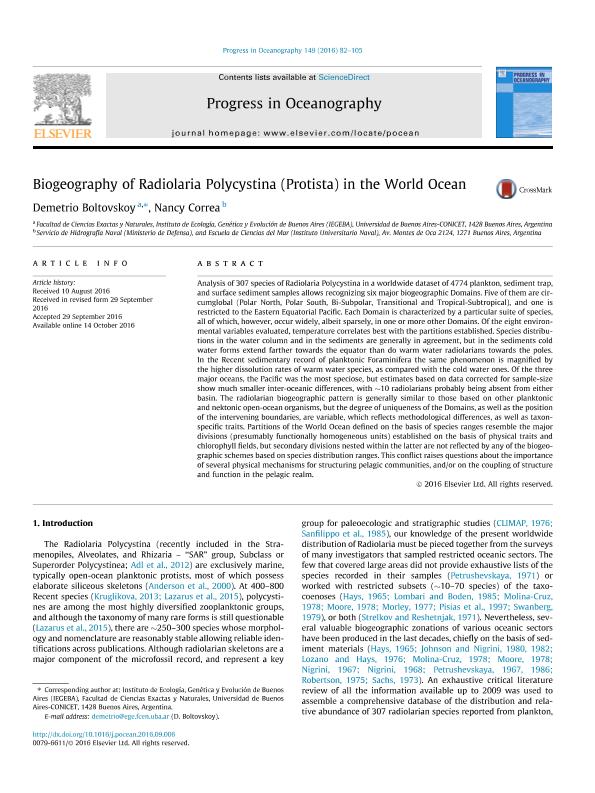Artículo
Biogeography of Radiolaria Polycystina (Protista) in the World Ocean
Fecha de publicación:
12/2016
Editorial:
Pergamon-Elsevier Science Ltd
Revista:
Progress In Oceanography
ISSN:
0079-6611
Idioma:
Inglés
Tipo de recurso:
Artículo publicado
Clasificación temática:
Resumen
Analysis of 307 species of Radiolaria Polycystina in a worldwide dataset of 4774 plankton, sediment trap, and surface sediment samples allows recognizing six major biogeographic Domains. Five of them are circumglobal (Polar North, Polar South, Bi-Subpolar, Transitional and Tropical-Subtropical), and one is restricted to the Eastern Equatorial Pacific. Each Domain is characterized by a particular suite of species, all of which, however, occur widely, albeit sparsely, in one or more other Domains. Of the eight environmental variables evaluated, temperature correlates best with the partitions established. Species distributions in the water column and in the sediments are generally in agreement, but in the sediments cold water forms extend farther towards the equator than do warm water radiolarians towards the poles. In the Recent sedimentary record of planktonic Foraminifera the same phenomenon is magnified by the higher dissolution rates of warm water species, as compared with the cold water ones. Of the three major oceans, the Pacific was the most speciose, but estimates based on data corrected for sample-size show much smaller inter-oceanic differences, with ∼10 radiolarians probably being absent from either basin. The radiolarian biogeographic pattern is generally similar to those based on other planktonic and nektonic open-ocean organisms, but the degree of uniqueness of the Domains, as well as the position of the intervening boundaries, are variable, which reflects methodological differences, as well as taxon-specific traits. Partitions of the World Ocean defined on the basis of species ranges resemble the major divisions (presumably functionally homogeneous units) established on the basis of physical traits and chlorophyll fields, but secondary divisions nested within the latter are not reflected by any of the biogeographic schemes based on species distribution ranges. This conflict raises questions about the importance of several physical mechanisms for structuring pelagic communities, and/or on the coupling of structure and function in the pelagic realm.
Palabras clave:
Radiolaria
,
Polycystina
,
Biogeography
,
World Ocean
Archivos asociados
Licencia
Identificadores
Colecciones
Articulos(IEGEBA)
Articulos de INSTITUTO DE ECOLOGIA, GENETICA Y EVOLUCION DE BS. AS
Articulos de INSTITUTO DE ECOLOGIA, GENETICA Y EVOLUCION DE BS. AS
Citación
Boltovskoy, Demetrio; Correa, Nancy Myriam; Biogeography of Radiolaria Polycystina (Protista) in the World Ocean; Pergamon-Elsevier Science Ltd; Progress In Oceanography; 149; 12-2016; 82-105
Compartir
Altmétricas




